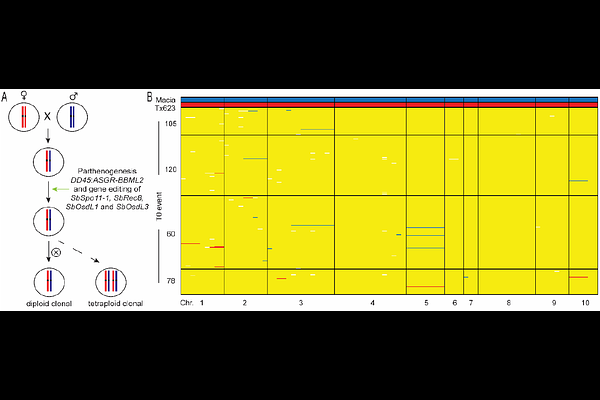Induction of synthetic apomixis in two sorghum hybrids enables seed yield and genotype preservation over multiple generations

Induction of synthetic apomixis in two sorghum hybrids enables seed yield and genotype preservation over multiple generations
Simon, M. K.; Yuan, L.; Che, P.; Day, K.; Jones, T.; Godwin, I. D.; Koltunow, A.; Albertsen, M. C.
AbstractApomixis, a process of clonal reproduction through seed, has the potential to significantly change agriculture by enabling a clonal seed propagation system for hybrid crops. Here, we demonstrate that hybrid seed from synthetically induced apomictic sorghum hybrids can be generated and maintained across multiple seed generations. This was achieved through the combination of avoidance of meiosis and induced parthenogenesis. Avoidance of meiosis was generated by the CRISPR/Cas9 knockout of the sorghum meiosis genes Spo11, Rec8, and OsdL1 and OsdL3. Parthenogenesis was induced in the resultant diploid egg cell using a maize egg cell promoter to express the Cenchrus ASGR-BBML2 gene coding sequence. Two strategies incorporating these components were used to induce synthetic apomixis in two different sorghum hybrids. Each hybrid used Tx623 as a female parent and either Tx430 or the African landrace Macia as a male parent. Seed yields in the induced apomictic hybrids were consistent and stable for multiple generations following self-pollination but reduced relative to the sexual hybrids. Sorghum contains two copies of the Osd1 gene that function in meiotic non-reduction. CRISPR/Cas9 knockout of both OsdL1 and OsdL3 loci was sufficient to produce clonal hybrid progeny in conjunction with the other apomixis induction components, but this led to a significant reduction in seed set. By contrast, a single in-frame edit of either OsdL1 or OsdL3 significantly improved seed set of clonal hybrid progeny. Fine-tuning OsdL activity appears to be essential to optimizing fertility. As the efficiency of seed set in the induced synthetic sorghum apomicts was lower than that of the sexual hybrid control, additional improvements are required to unlock the agronomic potential of synthetically induced apomictic sorghum in the field.